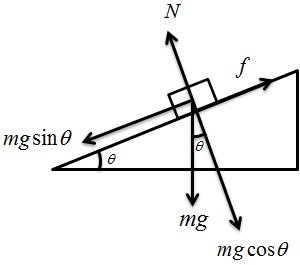Question
In: Physics
The coefficient of static friction between teflon and scrambled eggs is about 0.04. What is the...
The coefficient of static friction between teflon and scrambled
eggs is about 0.04.
What is the smallest angle from the horizontal that will cause the
eggs to slide across the bottom of the Teflon-coated skiller?
Solutions
Expert Solution
Let m be the mass of the eggs.
The coefficient of static friction between teflon and scrambled eggs is
 s = 0.04
s = 0.04
The free body diagram of the eggs slide across the Teflon-coated skiller is shown below:

From the figure, the normal force acting on the eggs is
N = mg cos 
Here, acceleartion due to gravity is g.
The static friction between the Teflon and scrambled eggs is
f =  s N
s N
=  s mg
cos
s mg
cos
For the eggs to slide across the skiller,
mg sin  >
>  s
mg cos
s
mg cos 
tan  >
>  s
s
 >
tan-1 (
>
tan-1 ( s)
s)
Substitute 0.04 for  s in the above
equation,
s in the above
equation,
 >
tan-1 (
>
tan-1 ( s)
s)
> tan-1 (0.04)
> 2.29060
Rounding off to two significant figures, the smallest angle from the horizontal that will cause the eggs to slide across the bottom of the Teflon-coated skiller is 2.30.
Related Solutions
In the first part of this lab, you will find the coefficient of static friction between...
The coefficient of friction (static and kinetic) between an object and a surface can be measured...
#4. A vase was placed on the coffee table. The coefficient of static friction between the...
Block A weighs 445N and block B weighs 130N. The coefficient of static friction between the...
Block A weighs 445N and block B weighs 130N. The coefficient of static friction between the...
A mass of 8 kg rests on a floor with a coefficient of static friction of...
A mass of 9 kg rests on a floor with a coefficient of static friction of...
A mass of 6 kg is placed on an incline with a coefficient of static friction...
If the coefficient of static friction is 0.60, and the same ladder makes a 46° angle...
1) What units do the Coefficient of Static (µs) and Kinetic (µk) friction have? 2)If the...
- If the density of the universe great than a critical value, then it might continue expanding...
- A 16.4-kg block rests on a horizontal table and is attached to one end of a...
- Freud’s theory of defense mechanisms has had a profound impact on the methods used by therapist,...
- discuss what a disclaimer is, when is it is issued, and how it would affect the...
- Explain why 1 additional net ATP is produced when the beginning substrate is glycogen compared to...
- What is Sales Tax, its salient features and how it works, do a comparative analysis between...
- E8-10 (Algo) Computing Depreciation under Alternative Methods LO8-3 Strong Metals Inc. purchased a new stamping machine...
 genius_generous answered 1 month ago
genius_generous answered 1 month ago